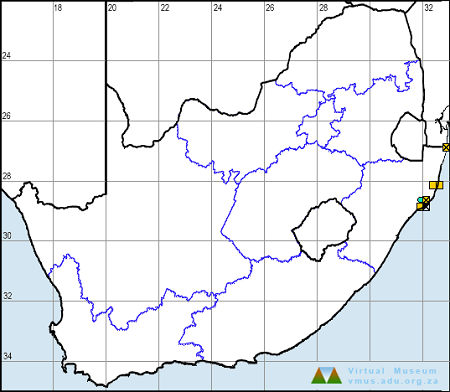Cover photo by Richard Johnstone.
Find the Smoky Duskdarter in the FBIS database (Freshwater Biodiversity Information System) here.
Family Libellulidae
Identification

Enseleni Nature Reserve, KwaZulu-Natal
Photo by Diana Russell
Inset images by Kate Braun
Medium sized
Length up tp 47mm; Wingspan attains 72mm.
The Smoky Duskdarter most closely resembles Gynacantha usambarica (Eastern Duskhawker). The Smoky Duskdarter is easily told apart by its far smaller size, different wing venation and by its large green eyes that have three rows of thin brown across the top.
Click here for more details on identification of the Smoky Duskdarter.
Habitat
The Smoky Duskdarter inhabits subtropical or tropical moist lowland forests and shrub-dominated wetlands. In South Africa it occurs mainly in lush swamp forests along the northern KwaZulu-Natal coast.

Kosi Bay, iSimangaliso Wetland Park, KwaZulu-Natal
Photo by Lauren Arnold
Behaviour
The Smoky Duskdarter is Crepuscular, being most active at dusk but is also active during humid, overcast conditions. It hunts by coursing low over tree-covered water bodies.The Smoky Duskdarter rests by day in the deep shade of dense undergrowth. It hangs vertically when perched.
The Smoky Duskdarter is on the wing from December to April.
Status and Conservation
Zyxomma atlanticum is scarce and highly localised in South Africa. It is listed as of Least Concern in the IUCN Red List of Threatened Species.
Distribution
The Smoky Duskdarter is most widespread in the forested regions of West and Central Africa. It also occurrs locally along the south-east African coast in southern Mozambique and far north-eastern South Africa, where it ranges from Kosi Bay down to Richards Bay.
Below is a map showing the distribution of records for Smoky Duskdarter in the OdonataMAP database as at February 2020.
Below is a map showing the distribution of records for Smoky Duskdarter in the OdonataMAP database as of December 2024.

The next map below is an imputed map, produced by an interpolation algorithm, which attempts to generate a full distribution map from the partial information in the map above. This map will be improved by the submission of records to the OdonataMAP section of the Virtual Museum.


Ultimately we will produce a series of maps for all the odonata species in the region. The current algorithm is a new algorithm. The objective is mainly to produce “smoothed” maps that could go into a field guide for odonata. This basic version of the algorithm (as mapped above) does not make use of “explanatory variables” (e.g. altitude, terrain roughness, presence of freshwater — we will be producing maps that take these variables into account soon). Currently, it only makes use of the OdonataMAP records for the species being mapped, as well as all the other records of all other species. The basic maps are “optimistic” and will generally show ranges to be larger than what they probably are.
These maps use the data in the OdonataMAP section of the Virtual Museum, and also the database assembled by the previous JRS funded project, which was led by Professor Michael Samways and Dr KD Dijkstra.

Photo by Kate Braun
Further Resources
The use of photographs by Diana Russell, Lauren Arnold, and Richard Johnstone is acknowledged.
Smoky Duskdarter Zyxomma atlanticum Selys, 1889
Other Common Names: Donkerskemerwerper (Afrikaans).
Recommended citation format: Loftie-Eaton M; Navarro R; Tippett RM; Underhill L. 2025. Smoky Duskdarter Zyxomma atlanticum. Biodiversity and Development Institute. Available online at https://thebdi.org/2020/02/18/smoky-duskdarter-zyxomma-atlanticum/
References: Tarboton, M; Tarboton, W. (2019). A Guide to the Dragonflies & Damselflies of South Africa. Struik Nature.
Samways, MJ. (2008). Dragonflies and Damselflies of South Africa. Pensoft
Samways, MJ. (2016). Manual of Freshwater Assessment for South Africa: Dragonfly Biotic Index. Suricata 2. South African National Biodiversity Institute, Pretoria


